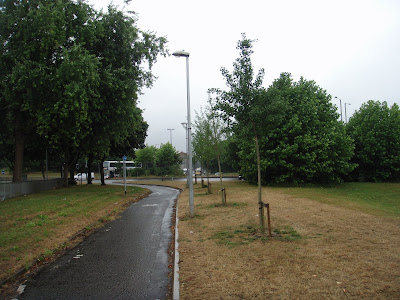This is Redland Green.
And the photo shows the Ash trees we've been trying to save, together with a Hawthorn that's seen better days, but is still important in the park.
We have watched this tree carefully over the last couple of years and it has to be said that it has been going through a rough patch - perhaps as a result of the construction of the cycle path next to it. So we were wondering if it might do better next year.....
But on Tuesday, this tree was removed by Bristol City Council, quite unexpectedly. No warning, no consultation, nothing.
Redland Green is no stranger to controversy and we have made the case that Bristol City Council should consult before taking decisions like this. The urban forest is inhabited by people - like us.
We've felt for a long time that if the council consulted, it would then be in possession of all the information and therefore able to make better decisions. Also, it would be a way of engaging the local community rather than simply ignoring us. The council knows very well who to consult but it seems to ignore us utterly. It thinks it knows best. But we have successfully challenged, at an expert and technical level, its risk assessments and even had technical papers published in the Arboricultural Journal. We think that the council doesn't always know best.
So we have sent this email to Bristol City Council (which thought the tree was dead - it is now):
FAO Richard Ennion, Bristol Parks Department
cc Bristol Tree Forum
cc Councillors Townsend and Harrison
cc RCAS
cc Redland Green Community Group
Dear Richard,
Earlier this week, probably Tuesday, an ancient hawthorn tree was removed on Redland Green without any warning or consultation. It is likely to have been the oldest tree in the park. As you may know this section of Redland Green is part of a former rural landscape which predates the mainly Victorian houses which surround it.
We will need to discuss how we can protect from BCC the remaining treees of this historic landscape at our next meeting of the Redland Green Community Group on Monday.
We had hoped that Bristol City Council might have learned the value of consulting with the local community before removing such trees, especially following the controversy regarding BCC's plan to chainsaw the ancient ash trees. But it appears not.
Of course, post facto, it is possible to justify the removal of the tree. And yes, we know the standard arguments that can be pulled out, which would apply to pretty much any tree over 50 years old. But this approach is simply unacceptible as it does not allow the community to consider BCC's reasons for removing trees and decide whether we are comfortable with them. Nor does it allow us to obtain technical expert opnion to challenge the views of BCC as we did partially successfully with the ancient ash trees on Redland Green which BCC was determined to remove.
I personally find it hard to understand the reason for removing this live tree, whilst leaving a completely dead tree at the other end of the park. It beats me.
For the moment, I guess all we can do is to get maximum publicity within our community and elsewhere to try and prevent the next episode of random destruction.
Yours faithfully,
Vassili Papastavrou
www.BristolStreetTrees.org























